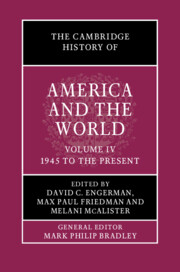Book contents
- The Cambridge History of America and the World
- The Cambridge History of America and the World
- The Cambridge History of America and the World
- Copyright page
- Contents
- Figures
- Maps
- Contributors to Volume IV
- General Introduction: What is America and the World?
- Introduction to Volume IV
- Part I Ordering a World of States
- Part II Challenging a World of States
- Part III New World Disorder?
- 23 The Illusions of the United States’ Great Power Politics after the Cold War
- 24 Neoliberalism as a Form of US Power
- 25 The US Construction of “Islam” as Ally and Enemy on the Global Stage
- 26 Technology and Networks of Communication
- 27 Humanitarian Intervention and US Power
- 28 Refugees, Statelessness, and the Disordering of Citizenship
- 29 Liberty, Security, and America’s War on Terror
- 30 The Global Wars on Terror
- 31 America and the World in the Anthropocene
- Index
- References
23 - The Illusions of the United States’ Great Power Politics after the Cold War
from Part III - New World Disorder?
Published online by Cambridge University Press: 12 November 2021
- The Cambridge History of America and the World
- The Cambridge History of America and the World
- The Cambridge History of America and the World
- Copyright page
- Contents
- Figures
- Maps
- Contributors to Volume IV
- General Introduction: What is America and the World?
- Introduction to Volume IV
- Part I Ordering a World of States
- Part II Challenging a World of States
- Part III New World Disorder?
- 23 The Illusions of the United States’ Great Power Politics after the Cold War
- 24 Neoliberalism as a Form of US Power
- 25 The US Construction of “Islam” as Ally and Enemy on the Global Stage
- 26 Technology and Networks of Communication
- 27 Humanitarian Intervention and US Power
- 28 Refugees, Statelessness, and the Disordering of Citizenship
- 29 Liberty, Security, and America’s War on Terror
- 30 The Global Wars on Terror
- 31 America and the World in the Anthropocene
- Index
- References
Summary
For American policymakers, the end of the Cold War was, above all, a self-affirming experience. The four decades of global competition with Soviet communism had cast doubt on whether the United States was the most powerful or most righteous country in the world, but the peaceful and precipitous collapse of communism in the late 1980s appeared to confirm that it was indeed both. Looking to the future in the early 1990s, American policymakers were guided by two steadfast beliefs. First, they believed that the United States should remain the most powerful country in the world, and that American primacy in world affairs would receive the consent of the vast majority of other countries for the foreseeable future. Second, they believed that the United States’ form of political and economic organization – liberal democratic capitalism – was destined to benignly conquer the globe, and that it was the job of the US government to accelerate its expansion.
- Type
- Chapter
- Information
- The Cambridge History of America and the World , pp. 537 - 559Publisher: Cambridge University PressPrint publication year: 2022

